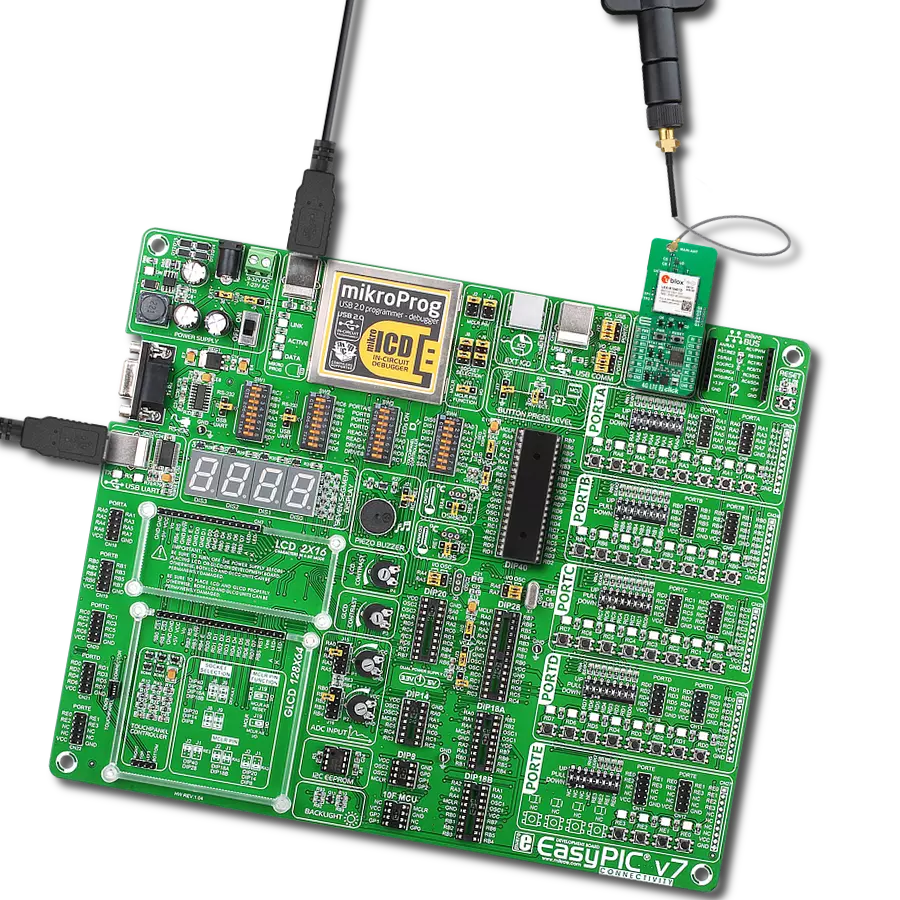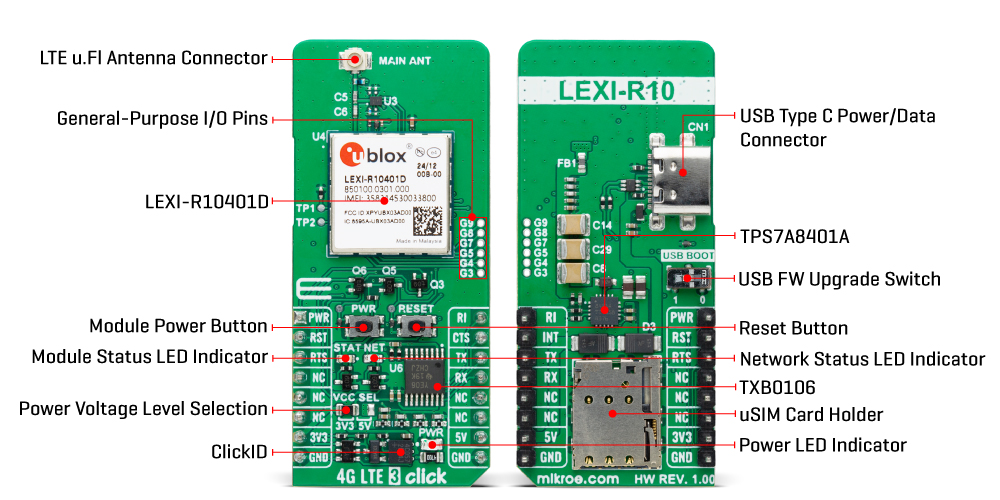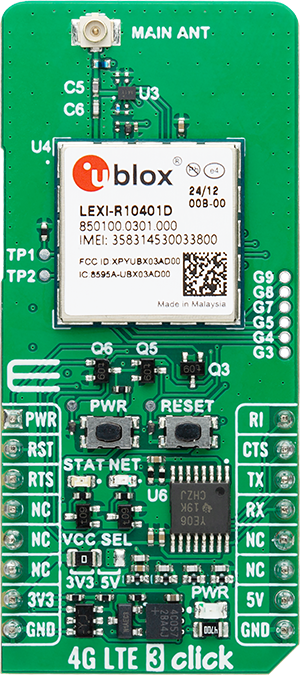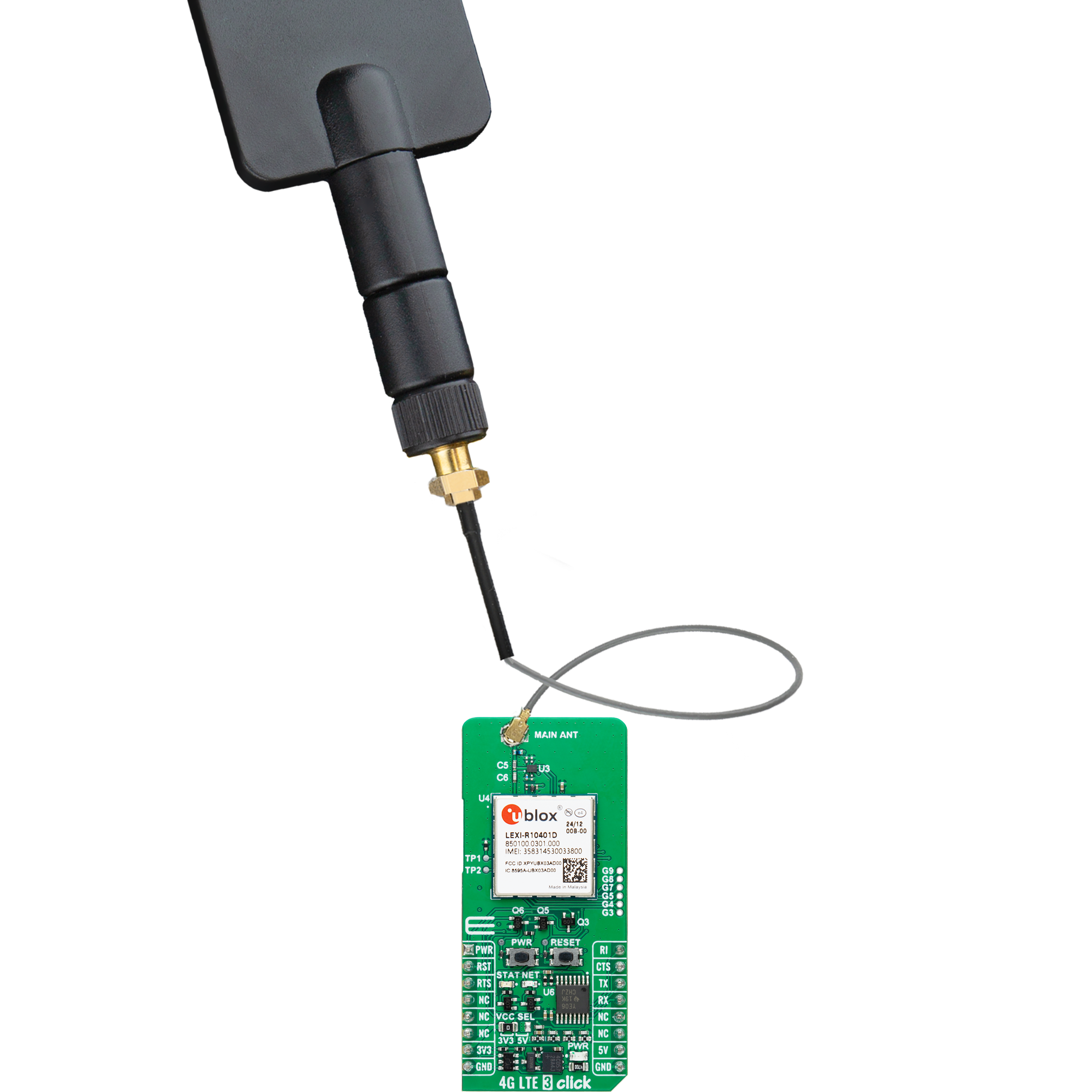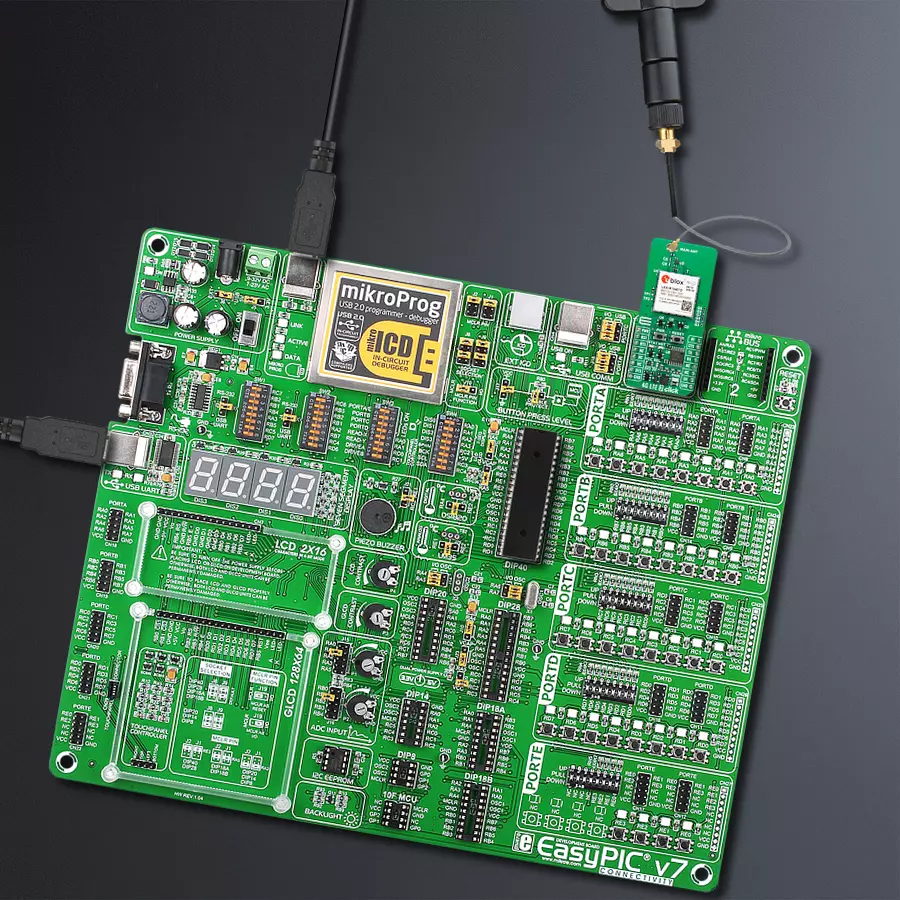支持室内定位的 LTE Cat 1bis 连接,适用于北美地区的资产追踪、车载远程信息处理和可穿戴设备应用
A
A
硬件概览
它是如何工作的?
4G LTE 3 Click(适用于北美)基于 u-blox 的 LEXI-R10401D 单模 LTE Cat 1bis 模块,专为在美国地区需要可靠连接、中等数据速率和广泛网络覆盖的应用而设计。该模块符合专业级标准,遵循 u-blox 的质量认证政策并满足 AEC-Q104 标准。它支持多个 LTE FDD 频段,包括 2、4、5、12、13、14、66 和 71,可在多个地区网络中提供广泛兼容性和出色性能。此外,LEXI-R10401D 通过了 PTCRB、GCF、FCC、ISED、AT\&T、Verizon 和 FirstNet 等认证,可在各支持市场中部署。除了基本的 LTE 功能外,模块还集成了嵌入式 Wi-Fi 扫描功能,可用于定位附近 Wi-Fi 热点,从而增强室内定位能力,并支持 u-blox 的 CellLocate® 地理定位服务。该模块体积紧凑、集成度高,支持中等速率的数据连接,下载速度最高可达 10Mbps,上传速度可达 5Mbps,同时保持极低的功耗,特别适用于注重成本控制但仍需稳定数据连接的场景,如资产追踪、远程信息处理、医疗设备和可穿戴设备等。模块通过 UART 接口与主控 MCU 通信,
使用标准 UART RX 和 TX 引脚,以及硬件流控引脚(CTS/RTS/RI)以实现高效数据传输,默认通信速率为 115200bps,支持基于 AT 指令的数据交互。板上还配备了一个 USB Type-C 接口,用于供电和数据传输,符合 USB 2.0 标准,最大数据速率为 480Mbit/s(仅外围设备模式)。此外,板背面带有一个名为 USB BOOT 的 USB 固件升级开关,可通过将开关拨至位置 1 来启用固件升级功能,位置 0 则为正常工作状态,确保升级过程简单直观。4G LTE 3 Click 板还提供多项增强功能以提高可用性与控制能力。板载 PWR 按钮可实现模块的手动开关机,RESET 按钮可用于快速重置模块,这些操作也可通过 mikroBUS™ 插针上的 PWR 与 RST 信号进行数字控制,从而提供更多灵活性。板载未焊接的 6 个 GPIO 扩展针脚为用户提供额外功能配置空间,同时板上还预留了 TP1 和 TP2 两个测试点,便于诊断使用,尤其适用于同时使用 USB 与主 UART 接口的场景。板上配有两个状态指示灯用于实时显示模块状态。红色 NET LED 表示
网络状态,当 LED 慢速闪烁时表示已注册至网络,正常闪烁表示尚未注册网络,快速闪烁表示正在进行数据传输;当该指示灯熄灭时表示模块已关机或处于省电模式(PSM)。黄色 STAT LED 表示模块电源状态,模块关闭时指示灯熄灭,模块上电或固件启动完成时指示灯点亮。通信天线方面,该板配有一个 u.Fl 天线连接器,可连接 MIKROE 提供的 LTE 扁平旋转天线,并通过 IPEX-SMA 线缆实现灵活的天线连接。另配有 micro SIM 卡座,兼容 1.8V 与 3.0V 的 uSIM 卡,用户可根据实际需求选择合适的运营商服务。此 Click 板支持 3.3V 与 5V 逻辑电平,可通过 VCC SEL 跳线选择。由于 LEXI-R10401D 工作电压为 3.8V,板上使用了 TXB0106 逻辑电平转换器以实现电平兼容,从而确保与不同逻辑电平的 MCU 正确通信。该 Click 板还配有配套的软件库与示例代码,提供易用的函数接口,可供进一步开发参考使用。
功能概述
开发板
EasyPIC v7 是第七代 PIC 开发板,专为快速开发嵌入式应用而设计。它支持 Microchip 的广泛 8 位 PIC 微控制器,并具备一系列独特功能,如强大的板载 mikroProg 程序员和通过 USB-B 的在线电路调试器。开发板布局合理,设计周到,确保最终用户在一个地方可以找到所有必需的元素,如开关、按钮、指示器、连接器等。EasyPIC v7 提供四种不同的连接器用于每个端口,使您能够比以往更高效地连接附件板、传感器和自定义电子设备。EasyPIC v7 开发板的每个
部分都包含了使同一板块运行最高效的必要组件。一个集成的 mikroProg、一个快速的 USB 2.0 程序器带有 mikroICD 硬件在线电路调试器,提供许多宝贵的编程/调试选项并与 Mikroe 软件环境无缝集成。此外,它还包括一个为开发板提供的干净且调节过的电源模块。它可以使用各种外部电源,包括外部 12V 电源、7-23V 交流或 9-32V 直流通过 DC 连接器/螺丝端子,以及通过 USB Type-B(USB-B)连接器的电源。通信选项如 USB-UART 和 RS-232 也包括在
内,还有广受好评的 mikroBUS™ 标准、三种显示选项(七段、图形和基于字符的 LCD),以及几种不同的 DIP 插座。这些插座覆盖了广泛的 8 位 PIC MCU,包括 PIC10F, PIC12F, PIC16F, PIC16Enh, PIC18F, PIC18FJ, 和 PIC18FK 系列。EasyPIC v7 是 Mikroe 快速开发生态系统的一个重要组成部分,由 Mikroe 软件工具原生支持,得益于大量不同的 Click 板™(超过一千块板),其数量每天都在增长,它涵盖了原型制作和开发的许多方面。
微控制器概述
MCU卡片 / MCU
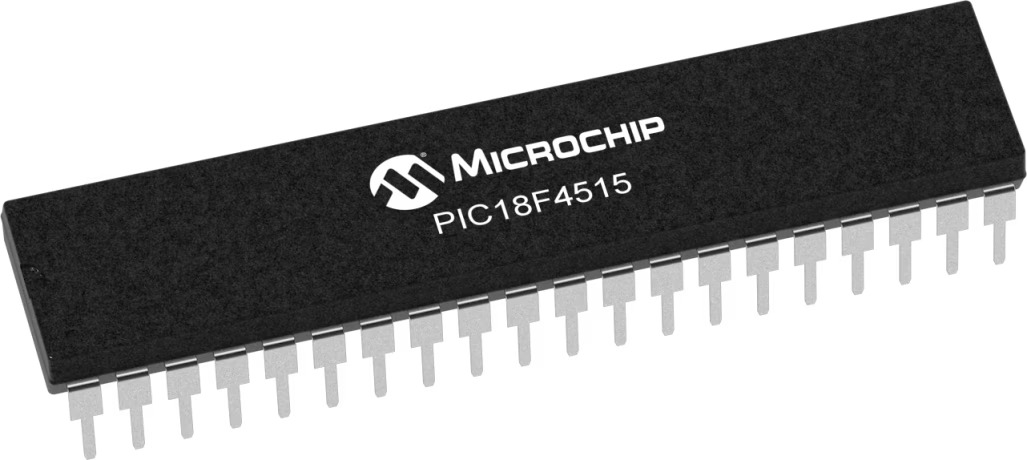
建筑
PIC
MCU 内存 (KB)
48
硅供应商
Microchip
引脚数
40
RAM (字节)
3968
你完善了我!
配件
LTE Flat Rotation Antenna 是增强 3G/4G LTE 设备性能的多功能选择。凭借 700-2700MHz 的宽频率范围,它确保在全球主要蜂窝频段上的最佳连接。该平板天线采用 SMA 公头连接器,便于直接连接到设备或 SMA 模块连接器。其亮点之一是可调角度,可按 45⁰ 增量(0⁰/45⁰/90⁰)设置,允许您微调天线的方向以获得最佳信号接收。具有 50Ω 阻抗和 <2.0:1 的电压驻波比 (VSWR),此天线确保可靠高效的连接。其 5dB 增益、垂直极化和全向辐射图形增强了信号强度,适用于各种应用。天线长度为 196mm,宽度为 38mm,提供紧凑但有效的解决方案来改善您的连接。最大输入功率为 50W,能够满足各种设备的需求。

IPEX-SMA 电缆是一种射频 (RF) 电缆组件。"IPEX" 指的是 IPEX 连接器,这是一种常用于小型电子设备的微型同轴连接器。"SMA" 代表 SubMiniature Version A,是另一种常用于射频应用的同轴连接器。IPEX-SMA 电缆组件的一端是 IPEX 连接器,另一端是 SMA 连接器,使其能够连接使用这些特定连接器的设备或组件。这些电缆常用于 WiFi 或蜂窝天线、GPS 模块以及其他需要可靠且低损耗连接的射频通信系统。

使用的MCU引脚
mikroBUS™映射器
“仔细看看!”
Click board™ 原理图

一步一步来
项目组装
实时跟踪您的结果
应用程序输出
1. 应用程序输出 - 在调试模式下,“应用程序输出”窗口支持实时数据监控,直接提供执行结果的可视化。请按照提供的教程正确配置环境,以确保数据正确显示。

2. UART 终端 - 使用UART Terminal通过USB to UART converter监视数据传输,实现Click board™与开发系统之间的直接通信。请根据项目需求配置波特率和其他串行设置,以确保正常运行。有关分步设置说明,请参考提供的教程。

3. Plot 输出 - Plot功能提供了一种强大的方式来可视化实时传感器数据,使趋势分析、调试和多个数据点的对比变得更加直观。要正确设置,请按照提供的教程,其中包含使用Plot功能显示Click board™读数的分步示例。在代码中使用Plot功能时,请使用以下函数:plot(insert_graph_name, variable_name);。这是一个通用格式,用户需要将“insert_graph_name”替换为实际图表名称,并将“variable_name”替换为要显示的参数。

软件支持
库描述
4G LTE 3 Click (for North America) 演示应用程序使用 NECTO Studio开发,确保与 mikroSDK 的开源库和工具兼容。该演示设计为即插即用,可与所有具有 mikroBUS™ 插座的 开发板、入门板和 mikromedia 板完全兼容,用于快速实现和测试。
示例描述
本应用示例展示了设备通过标准 "AT" 命令连接至网络并发送短信或 TCP/UDP 消息的能力。
关键功能:
c4glte3na_cfg_setup- 初始化 Click 配置结构体。c4glte3na_init- 初始化所有必要的引脚与外设。c4glte3na_set_sim_apn- 设置 SIM 卡的 APN 接入点名称。c4glte3na_send_sms_text- 向指定手机号发送短信文本。c4glte3na_cmd_run- 向模块发送指定的 AT 命令。
应用初始化
初始化驱动程序与日志记录器。
应用任务
任务流程被分为多个阶段:
C4GLTE3NA_POWER_UP:上电模块,执行出厂重置,并读取系统信息。C4GLTE3NA_CONFIG_CONNECTION:配置模块以便连接至网络。C4GLTE3NA_CHECK_CONNECTION:等待模块通过 CEREG 命令注册到网络,并检测信号强度。C4GLTE3NA_CONFIG_EXAMPLE:为所选示例配置模块。C4GLTE3NA_EXAMPLE:根据所选演示模式,发送短信(PDU 或 TXT 模式)或 TCP/UDP 消息,默认设置为 TCP/UDP 示例。
开源
代码示例
完整的应用程序代码和一个现成的项目可以通过NECTO Studio包管理器直接安装到NECTO Studio。 应用程序代码也可以在MIKROE的GitHub账户中找到。
/*!
* @file main.c
* @brief 4G LTE 3 NA Click Example.
*
* # Description
* Application example shows device capability of connecting to the network and
* sending SMS or TCP/UDP messages using standard "AT" commands.
*
* The demo application is composed of two sections :
*
* ## Application Init
* Initializes the driver and logger.
*
* ## Application Task
* Application task is split in few stages:
* - C4GLTE3NA_POWER_UP:
* Powers up the device, performs a factory reset and reads system information.
*
* - C4GLTE3NA_CONFIG_CONNECTION:
* Sets configuration to device to be able to connect to the network.
*
* - C4GLTE3NA_CHECK_CONNECTION:
* Waits for the network registration indicated via CEREG command and then checks
* the signal quality report.
*
* - C4GLTE3NA_CONFIG_EXAMPLE:
* Configures device for the selected example.
*
* - C4GLTE3NA_EXAMPLE:
* Depending on the selected demo example, it sends an SMS message (in PDU or TXT mode) or TCP/UDP message.
*
* By default, the TCP/UDP example is selected.
*
* ## Additional Function
* - static void c4glte3na_clear_app_buf ( void )
* - static void c4glte3na_log_app_buf ( void )
* - static err_t c4glte3na_process ( c4glte3na_t *ctx )
* - static err_t c4glte3na_read_response ( c4glte3na_t *ctx, uint8_t *rsp )
* - static err_t c4glte3na_power_up ( c4glte3na_t *ctx )
* - static err_t c4glte3na_config_connection ( c4glte3na_t *ctx )
* - static err_t c4glte3na_check_connection ( c4glte3na_t *ctx )
* - static err_t c4glte3na_config_example ( c4glte3na_t *ctx )
* - static err_t c4glte3na_example ( c4glte3na_t *ctx )
*
* @note
* In order for the examples to work, user needs to set the APN and SMSC (SMS PDU mode only)
* of entered SIM card as well as the phone number (SMS mode only) to which he wants to send an SMS.
* Enter valid values for the following macros: SIM_APN, SIM_SMSC and PHONE_NUMBER.
* Example:
SIM_APN "internet"
SIM_SMSC "+381610401"
PHONE_NUMBER "+381659999999"
*
* @author Stefan Filipovic
*
*/
#include "board.h"
#include "log.h"
#include "c4glte3na.h"
#include "generic_pointer.h"
#include "conversions.h"
// Example selection macros
#define EXAMPLE_TCP_UDP 0 // Example of sending messages to a TCP/UDP echo server
#define EXAMPLE_SMS 1 // Example of sending SMS to a phone number
#define DEMO_EXAMPLE EXAMPLE_TCP_UDP // Example selection macro
// SIM APN config
#define SIM_APN "internet" // Set valid SIM APN
// SMS example parameters
#define SIM_SMSC "" // Set valid SMS Service Center Address - only in SMS PDU mode
#define PHONE_NUMBER "" // Set Phone number to message
#define SMS_MODE "1" // SMS mode: "0" - PDU, "1" - TXT
// TCP/UDP example parameters
#define REMOTE_IP "77.46.162.162" // TCP/UDP echo server IP address
#define REMOTE_PORT "51111" // TCP/UDP echo server port
// Message content
#define MESSAGE_CONTENT "4G LTE 3 NA Click board - demo example."
// Application buffer size
#define APP_BUFFER_SIZE 256
#define PROCESS_BUFFER_SIZE 256
/**
* @brief Example states.
* @details Predefined enum values for application example state.
*/
typedef enum
{
C4GLTE3NA_POWER_UP = 1,
C4GLTE3NA_CONFIG_CONNECTION,
C4GLTE3NA_CHECK_CONNECTION,
C4GLTE3NA_CONFIG_EXAMPLE,
C4GLTE3NA_EXAMPLE
} c4glte3na_app_state_t;
/**
* @brief Application example variables.
* @details Variables used in application example.
*/
static uint8_t app_buf[ APP_BUFFER_SIZE ] = { 0 };
static int32_t app_buf_len = 0;
static c4glte3na_app_state_t app_state = C4GLTE3NA_POWER_UP;
static c4glte3na_t c4glte3na;
static log_t logger;
/**
* @brief 4G LTE 3 NA clearing application buffer.
* @details This function clears memory of application buffer and reset its length.
* @note None.
*/
static void c4glte3na_clear_app_buf ( void );
/**
* @brief 4G LTE 3 NA log application buffer.
* @details This function logs data from application buffer to USB UART.
* @note None.
*/
static void c4glte3na_log_app_buf ( void );
/**
* @brief 4G LTE 3 NA data reading function.
* @details This function reads data from device and concatenates data to application buffer.
* @param[in] ctx : Click context object.
* See #c4glte3na_t object definition for detailed explanation.
* @return @li @c 0 - Read some data.
* @li @c -1 - Nothing is read.
* See #err_t definition for detailed explanation.
* @note None.
*/
static err_t c4glte3na_process ( c4glte3na_t *ctx );
/**
* @brief 4G LTE 3 NA read response function.
* @details This function waits for a response message, reads and displays it on the USB UART.
* @param[in] ctx : Click context object.
* See #c4glte3na_t object definition for detailed explanation.
* @param[in] rsp Expected response.
* @return @li @c 0 - OK response.
* @li @c -2 - Timeout error.
* @li @c -3 - Command error.
* @li @c -4 - Unknown error.
* See #err_t definition for detailed explanation.
* @note None.
*/
static err_t c4glte3na_read_response ( c4glte3na_t *ctx, uint8_t *rsp );
/**
* @brief 4G LTE 3 NA power up function.
* @details This function powers up the device, performs a factory reset and reads system information.
* @param[in] ctx : Click context object.
* See #c4glte3na_t object definition for detailed explanation.
* @return @li @c 0 - OK.
* @li @c != 0 - Read response error.
* See #err_t definition for detailed explanation.
* @note None.
*/
static err_t c4glte3na_power_up ( c4glte3na_t *ctx );
/**
* @brief 4G LTE 3 NA config connection function.
* @details This function configures and enables connection to the specified network.
* @param[in] ctx : Click context object.
* See #c4glte3na_t object definition for detailed explanation.
* @return @li @c 0 - OK.
* @li @c != 0 - Read response error.
* See #err_t definition for detailed explanation.
* @note None.
*/
static err_t c4glte3na_config_connection ( c4glte3na_t *ctx );
/**
* @brief 4G LTE 3 NA check connection function.
* @details This function checks the connection to network.
* @param[in] ctx : Click context object.
* See #c4glte3na_t object definition for detailed explanation.
* @return @li @c 0 - OK.
* @li @c != 0 - Read response error.
* See #err_t definition for detailed explanation.
* @note None.
*/
static err_t c4glte3na_check_connection ( c4glte3na_t *ctx );
/**
* @brief 4G LTE 3 NA config example function.
* @details This function configures device for the selected example.
* @param[in] ctx : Click context object.
* See #c4glte3na_t object definition for detailed explanation.
* @return @li @c 0 - OK.
* @li @c != 0 - Read response error.
* See #err_t definition for detailed explanation.
* @note None.
*/
static err_t c4glte3na_config_example ( c4glte3na_t *ctx );
/**
* @brief 4G LTE 3 NA example function.
* @details This function executes SMS or TCP/UDP depending on the DEMO_EXAMPLE macro.
* @param[in] ctx : Click context object.
* See #c4glte3na_t object definition for detailed explanation.
* @return @li @c 0 - OK.
* @li @c != 0 - Read response error.
* See #err_t definition for detailed explanation.
* @note None.
*/
static err_t c4glte3na_example ( c4glte3na_t *ctx );
void application_init ( void )
{
log_cfg_t log_cfg; /**< Logger config object. */
c4glte3na_cfg_t c4glte3na_cfg; /**< Click config object. */
/**
* Logger initialization.
* Default baud rate: 115200
* Default log level: LOG_LEVEL_DEBUG
* @note If USB_UART_RX and USB_UART_TX
* are defined as HAL_PIN_NC, you will
* need to define them manually for log to work.
* See @b LOG_MAP_USB_UART macro definition for detailed explanation.
*/
LOG_MAP_USB_UART( log_cfg );
log_init( &logger, &log_cfg );
log_info( &logger, " Application Init " );
// Click initialization.
c4glte3na_cfg_setup( &c4glte3na_cfg );
C4GLTE3NA_MAP_MIKROBUS( c4glte3na_cfg, MIKROBUS_1 );
if ( UART_ERROR == c4glte3na_init( &c4glte3na, &c4glte3na_cfg ) )
{
log_error( &logger, " Communication init." );
for ( ; ; );
}
log_info( &logger, " Application Task " );
app_state = C4GLTE3NA_POWER_UP;
log_printf( &logger, ">>> APP STATE - POWER UP <<<\r\n\n" );
}
void application_task ( void )
{
switch ( app_state )
{
case C4GLTE3NA_POWER_UP:
{
if ( C4GLTE3NA_OK == c4glte3na_power_up( &c4glte3na ) )
{
app_state = C4GLTE3NA_CONFIG_CONNECTION;
log_printf( &logger, ">>> APP STATE - CONFIG CONNECTION <<<\r\n\n" );
}
break;
}
case C4GLTE3NA_CONFIG_CONNECTION:
{
if ( C4GLTE3NA_OK == c4glte3na_config_connection( &c4glte3na ) )
{
app_state = C4GLTE3NA_CHECK_CONNECTION;
log_printf( &logger, ">>> APP STATE - CHECK CONNECTION <<<\r\n\n" );
}
break;
}
case C4GLTE3NA_CHECK_CONNECTION:
{
if ( C4GLTE3NA_OK == c4glte3na_check_connection( &c4glte3na ) )
{
app_state = C4GLTE3NA_CONFIG_EXAMPLE;
log_printf( &logger, ">>> APP STATE - CONFIG EXAMPLE <<<\r\n\n" );
}
break;
}
case C4GLTE3NA_CONFIG_EXAMPLE:
{
if ( C4GLTE3NA_OK == c4glte3na_config_example( &c4glte3na ) )
{
app_state = C4GLTE3NA_EXAMPLE;
log_printf( &logger, ">>> APP STATE - EXAMPLE <<<\r\n\n" );
}
break;
}
case C4GLTE3NA_EXAMPLE:
{
c4glte3na_example( &c4glte3na );
break;
}
default:
{
log_error( &logger, " APP STATE." );
break;
}
}
}
int main ( void )
{
/* Do not remove this line or clock might not be set correctly. */
#ifdef PREINIT_SUPPORTED
preinit();
#endif
application_init( );
for ( ; ; )
{
application_task( );
}
return 0;
}
static void c4glte3na_clear_app_buf ( void )
{
memset( app_buf, 0, app_buf_len );
app_buf_len = 0;
}
static void c4glte3na_log_app_buf ( void )
{
for ( int32_t buf_cnt = 0; buf_cnt < app_buf_len; buf_cnt++ )
{
log_printf( &logger, "%c", app_buf[ buf_cnt ] );
}
}
static err_t c4glte3na_process ( c4glte3na_t *ctx )
{
uint8_t rx_buf[ PROCESS_BUFFER_SIZE ] = { 0 };
int32_t overflow_bytes = 0;
int32_t rx_cnt = 0;
int32_t rx_size = c4glte3na_generic_read( ctx, rx_buf, PROCESS_BUFFER_SIZE );
if ( ( rx_size > 0 ) && ( rx_size <= APP_BUFFER_SIZE ) )
{
if ( ( app_buf_len + rx_size ) > APP_BUFFER_SIZE )
{
overflow_bytes = ( app_buf_len + rx_size ) - APP_BUFFER_SIZE;
app_buf_len = APP_BUFFER_SIZE - rx_size;
memmove ( app_buf, &app_buf[ overflow_bytes ], app_buf_len );
memset ( &app_buf[ app_buf_len ], 0, overflow_bytes );
}
for ( rx_cnt = 0; rx_cnt < rx_size; rx_cnt++ )
{
if ( rx_buf[ rx_cnt ] )
{
app_buf[ app_buf_len++ ] = rx_buf[ rx_cnt ];
}
}
return C4GLTE3NA_OK;
}
return C4GLTE3NA_ERROR;
}
static err_t c4glte3na_read_response ( c4glte3na_t *ctx, uint8_t *rsp )
{
#define READ_RESPONSE_TIMEOUT_MS 120000
uint32_t timeout_cnt = 0;
c4glte3na_clear_app_buf ( );
c4glte3na_process( ctx );
while ( ( 0 == strstr( app_buf, rsp ) ) &&
( 0 == strstr( app_buf, C4GLTE3NA_RSP_ERROR ) ) )
{
c4glte3na_process( ctx );
if ( timeout_cnt++ > READ_RESPONSE_TIMEOUT_MS )
{
c4glte3na_clear_app_buf( );
log_error( &logger, " Timeout!" );
return C4GLTE3NA_ERROR_TIMEOUT;
}
Delay_ms( 1 );
}
Delay_ms ( 200 );
c4glte3na_process( ctx );
c4glte3na_log_app_buf( );
if ( strstr( app_buf, rsp ) )
{
log_printf( &logger, "--------------------------------\r\n" );
return C4GLTE3NA_OK;
}
else if ( strstr( app_buf, C4GLTE3NA_RSP_ERROR ) )
{
log_error( &logger, " CMD!" );
return C4GLTE3NA_ERROR_CMD;
}
log_error( &logger, " Unknown!" );
return C4GLTE3NA_ERROR_UNKNOWN;
}
static err_t c4glte3na_power_up ( c4glte3na_t *ctx )
{
err_t error_flag = C4GLTE3NA_OK;
uint8_t power_state = C4GLTE3NA_POWER_STATE_OFF;
for ( ; ; )
{
c4glte3na_process( ctx );
c4glte3na_log_app_buf ( );
c4glte3na_clear_app_buf ( );
// Wake up UART interface
c4glte3na_cmd_run( ctx, C4GLTE3NA_CMD_AT );
log_printf( &logger, ">>> Check communication.\r\n" );
c4glte3na_cmd_run( ctx, C4GLTE3NA_CMD_AT );
if ( ( ( C4GLTE3NA_OK == c4glte3na_process( ctx ) ) && strstr( app_buf, C4GLTE3NA_RSP_OK ) ) )
{
power_state = C4GLTE3NA_POWER_STATE_ON;
break;
}
else if ( C4GLTE3NA_POWER_STATE_OFF == power_state )
{
power_state = C4GLTE3NA_POWER_STATE_ON;
log_printf( &logger, ">>> Power up device.\r\n" );
c4glte3na_set_power_state ( ctx, C4GLTE3NA_POWER_STATE_ON );
}
else if ( C4GLTE3NA_POWER_STATE_ON == power_state )
{
power_state = C4GLTE3NA_POWER_STATE_OFF;
log_printf( &logger, ">>> Power down device.\r\n" );
c4glte3na_set_power_state ( ctx, C4GLTE3NA_POWER_STATE_OFF );
}
}
c4glte3na_cmd_run( ctx, C4GLTE3NA_CMD_AT );
error_flag |= c4glte3na_read_response( ctx, C4GLTE3NA_RSP_OK );
log_printf( &logger, ">>> Factory reset.\r\n" );
c4glte3na_cmd_run( ctx, C4GLTE3NA_CMD_FACTORY_RESET );
error_flag |= c4glte3na_read_response( ctx, C4GLTE3NA_RSP_OK );
log_printf( &logger, ">>> Get device software version ID.\r\n" );
c4glte3na_cmd_run( ctx, C4GLTE3NA_CMD_GET_SW_VERSION );
error_flag |= c4glte3na_read_response( ctx, C4GLTE3NA_RSP_OK );
log_printf( &logger, ">>> Get device serial number.\r\n" );
c4glte3na_cmd_run( ctx, C4GLTE3NA_CMD_GET_SERIAL_NUM );
error_flag |= c4glte3na_read_response( ctx, C4GLTE3NA_RSP_OK );
return error_flag;
}
static err_t c4glte3na_config_connection ( c4glte3na_t *ctx )
{
err_t error_flag = C4GLTE3NA_OK;
#if ( ( DEMO_EXAMPLE == EXAMPLE_TCP_UDP ) || ( DEMO_EXAMPLE == EXAMPLE_SMS ) )
log_printf( &logger, ">>> Configure network status LED.\r\n" );
#define NETWORK_STATUS_LED "14,2"
c4glte3na_cmd_set( ctx, C4GLTE3NA_CMD_GPIO_CONFIG, NETWORK_STATUS_LED );
error_flag |= c4glte3na_read_response( ctx, C4GLTE3NA_RSP_OK );
log_printf( &logger, ">>> Configure module status LED.\r\n" );
#define MODULE_STATUS_LED "15,10"
c4glte3na_cmd_set( ctx, C4GLTE3NA_CMD_GPIO_CONFIG, MODULE_STATUS_LED );
error_flag |= c4glte3na_read_response( ctx, C4GLTE3NA_RSP_OK );
log_printf( &logger, ">>> Deregister from network.\r\n" );
#define DEREGISTER_FROM_NETWORK "2"
c4glte3na_cmd_set( ctx, C4GLTE3NA_CMD_OPERATOR_SELECTION, DEREGISTER_FROM_NETWORK );
error_flag |= c4glte3na_read_response( ctx, C4GLTE3NA_RSP_OK );
log_printf( &logger, ">>> Set SIM APN.\r\n" );
c4glte3na_set_sim_apn( &c4glte3na, SIM_APN );
error_flag |= c4glte3na_read_response( ctx, C4GLTE3NA_RSP_OK );
log_printf( &logger, ">>> Enable full functionality.\r\n" );
#define FULL_FUNCTIONALITY "1"
c4glte3na_cmd_set( ctx, C4GLTE3NA_CMD_SET_MODULE_FUNCTIONALITY, FULL_FUNCTIONALITY );
error_flag |= c4glte3na_read_response( ctx, C4GLTE3NA_RSP_OK );
log_printf( &logger, ">>> Enable network registration.\r\n" );
#define ENABLE_REG "2"
c4glte3na_cmd_set( ctx, C4GLTE3NA_CMD_EPS_NETWORK_REGISTRATION, ENABLE_REG );
error_flag |= c4glte3na_read_response( ctx, C4GLTE3NA_RSP_OK );
log_printf( &logger, ">>> Set automatic registration.\r\n" );
#define AUTOMATIC_REGISTRATION "0"
c4glte3na_cmd_set( ctx, C4GLTE3NA_CMD_OPERATOR_SELECTION, AUTOMATIC_REGISTRATION );
error_flag |= c4glte3na_read_response( ctx, C4GLTE3NA_RSP_OK );
#endif
return error_flag;
}
static err_t c4glte3na_check_connection ( c4glte3na_t *ctx )
{
err_t error_flag = C4GLTE3NA_OK;
#if ( ( DEMO_EXAMPLE == EXAMPLE_TCP_UDP ) || ( DEMO_EXAMPLE == EXAMPLE_SMS ) )
log_printf( &logger, ">>> Check network registration.\r\n" );
#define CONNECTED "+CEREG: 2,1"
c4glte3na_cmd_get ( &c4glte3na, C4GLTE3NA_CMD_EPS_NETWORK_REGISTRATION );
error_flag |= c4glte3na_read_response( ctx, C4GLTE3NA_RSP_OK );
if ( strstr( app_buf, CONNECTED ) )
{
Delay_ms ( 1000 );
log_printf( &logger, ">>> Check signal quality.\r\n" );
c4glte3na_cmd_run ( &c4glte3na, C4GLTE3NA_CMD_SIGNAL_QUALITY_REPORT );
error_flag |= c4glte3na_read_response( ctx, C4GLTE3NA_RSP_OK );
}
else
{
error_flag = C4GLTE3NA_ERROR;
Delay_ms ( 1000 );
Delay_ms ( 1000 );
}
#endif
return error_flag;
}
static err_t c4glte3na_config_example ( c4glte3na_t *ctx )
{
err_t error_flag = C4GLTE3NA_OK;
#if ( DEMO_EXAMPLE == EXAMPLE_TCP_UDP )
log_printf( &logger, ">>> Activate PDP context.\r\n" );
#define ACTIVATE_PDP_CONTEXT "1,1"
c4glte3na_cmd_set( &c4glte3na, C4GLTE3NA_CMD_ACTIVATE_PDP_CONTEXT, ACTIVATE_PDP_CONTEXT );
error_flag |= c4glte3na_read_response( ctx, C4GLTE3NA_RSP_OK );
log_printf( &logger, ">>> Show PDP address.\r\n" );
#define PDP_CID "1"
c4glte3na_cmd_set( &c4glte3na, C4GLTE3NA_CMD_SHOW_PDP_ADDRESS, PDP_CID );
error_flag |= c4glte3na_read_response( ctx, C4GLTE3NA_RSP_OK );
#elif ( DEMO_EXAMPLE == EXAMPLE_SMS )
log_printf( &logger, ">>> Select SMS format.\r\n" );
c4glte3na_cmd_set( &c4glte3na, C4GLTE3NA_CMD_SELECT_SMS_FORMAT, SMS_MODE );
error_flag |= c4glte3na_read_response( ctx, C4GLTE3NA_RSP_OK );
#endif
return error_flag;
}
static err_t c4glte3na_example ( c4glte3na_t *ctx )
{
err_t error_flag = C4GLTE3NA_OK;
#if ( DEMO_EXAMPLE == EXAMPLE_TCP_UDP )
uint8_t cmd_buf[ 100 ] = { 0 };
uint8_t * __generic_ptr socket_num_buf = 0;
uint8_t tcp_socket_num[ 2 ] = { 0 };
uint8_t udp_socket_num[ 2 ] = { 0 };
log_printf( &logger, ">>> Create TCP socket.\r\n" );
#define TCP_PROTOCOL "6"
c4glte3na_cmd_set ( &c4glte3na, C4GLTE3NA_CMD_CREATE_SOCKET, TCP_PROTOCOL );
error_flag |= c4glte3na_read_response( ctx, C4GLTE3NA_RSP_OK );
socket_num_buf = strstr( app_buf, C4GLTE3NA_URC_CREATE_SOCKET ) + strlen ( C4GLTE3NA_URC_CREATE_SOCKET );
if ( NULL != socket_num_buf )
{
tcp_socket_num[ 0 ] = *socket_num_buf;
}
log_printf( &logger, ">>> Create UDP socket.\r\n" );
#define UDP_PROTOCOL "17"
c4glte3na_cmd_set ( &c4glte3na, C4GLTE3NA_CMD_CREATE_SOCKET, UDP_PROTOCOL );
error_flag |= c4glte3na_read_response( ctx, C4GLTE3NA_RSP_OK );
socket_num_buf = strstr( app_buf, C4GLTE3NA_URC_CREATE_SOCKET ) + strlen ( C4GLTE3NA_URC_CREATE_SOCKET );
if ( NULL != socket_num_buf )
{
udp_socket_num[ 0 ] = *socket_num_buf;
}
log_printf( &logger, ">>> Open TCP connection.\r\n" );
strcpy( cmd_buf, tcp_socket_num );
strcat( cmd_buf, ",\"" );
strcat( cmd_buf, REMOTE_IP );
strcat( cmd_buf, "\"," );
strcat( cmd_buf, REMOTE_PORT );
c4glte3na_cmd_set ( &c4glte3na, C4GLTE3NA_CMD_CONNECT_SOCKET, cmd_buf );
error_flag |= c4glte3na_read_response( ctx, C4GLTE3NA_RSP_OK );
log_printf( &logger, ">>> Open UDP connection.\r\n" );
strcpy( cmd_buf, udp_socket_num );
strcat( cmd_buf, ",\"" );
strcat( cmd_buf, REMOTE_IP );
strcat( cmd_buf, "\"," );
strcat( cmd_buf, REMOTE_PORT );
c4glte3na_cmd_set ( &c4glte3na, C4GLTE3NA_CMD_CONNECT_SOCKET, cmd_buf );
error_flag |= c4glte3na_read_response( ctx, C4GLTE3NA_RSP_OK );
// Get message length
uint8_t message_len_buf[ 10 ] = { 0 };
uint16_t message_len = strlen( MESSAGE_CONTENT );
uint16_to_str( message_len, message_len_buf );
l_trim( message_len_buf );
r_trim( message_len_buf );
log_printf( &logger, ">>> Write message to TCP connection.\r\n" );
strcpy( cmd_buf, tcp_socket_num );
strcat( cmd_buf, "," );
strcat( cmd_buf, message_len_buf );
strcat( cmd_buf, ",\"" );
strcat( cmd_buf, MESSAGE_CONTENT );
strcat( cmd_buf, "\"" );
c4glte3na_cmd_set ( &c4glte3na, C4GLTE3NA_CMD_WRITE_SOCKET_DATA, cmd_buf );
error_flag |= c4glte3na_read_response( ctx, C4GLTE3NA_URC_RECEIVED_DATA );
log_printf( &logger, ">>> Read response from TCP connection.\r\n" );
strcpy( cmd_buf, tcp_socket_num );
strcat( cmd_buf, "," );
strcat( cmd_buf, message_len_buf );
c4glte3na_cmd_set( &c4glte3na, C4GLTE3NA_CMD_READ_SOCKET_DATA, cmd_buf );
error_flag |= c4glte3na_read_response( ctx, C4GLTE3NA_RSP_OK );
log_printf( &logger, ">>> Write message to UDP connection.\r\n" );
strcpy( cmd_buf, udp_socket_num );
strcat( cmd_buf, "," );
strcat( cmd_buf, message_len_buf );
strcat( cmd_buf, ",\"" );
strcat( cmd_buf, MESSAGE_CONTENT );
strcat( cmd_buf, "\"" );
c4glte3na_cmd_set ( &c4glte3na, C4GLTE3NA_CMD_WRITE_SOCKET_DATA, cmd_buf );
error_flag |= c4glte3na_read_response( ctx, C4GLTE3NA_URC_RECEIVED_DATA );
log_printf( &logger, ">>> Read response from UDP connection.\r\n" );
strcpy( cmd_buf, udp_socket_num );
strcat( cmd_buf, "," );
strcat( cmd_buf, message_len_buf );
c4glte3na_cmd_set( &c4glte3na, C4GLTE3NA_CMD_READ_SOCKET_DATA, cmd_buf );
error_flag |= c4glte3na_read_response( ctx, C4GLTE3NA_RSP_OK );
log_printf( &logger, ">>> Close TCP connection.\r\n" );
c4glte3na_cmd_set ( &c4glte3na, C4GLTE3NA_CMD_CLOSE_SOCKET, tcp_socket_num );
error_flag |= c4glte3na_read_response( ctx, C4GLTE3NA_RSP_OK );
log_printf( &logger, ">>> Close UDP connection.\r\n" );
c4glte3na_cmd_set ( &c4glte3na, C4GLTE3NA_CMD_CLOSE_SOCKET, udp_socket_num );
error_flag |= c4glte3na_read_response( ctx, C4GLTE3NA_RSP_OK );
Delay_ms ( 1000 );
Delay_ms ( 1000 );
Delay_ms ( 1000 );
Delay_ms ( 1000 );
Delay_ms ( 1000 );
#elif ( DEMO_EXAMPLE == EXAMPLE_SMS )
#define CMGF_PDU "+CMGF: 0"
#define CMGF_TXT "+CMGF: 1"
log_printf( &logger, ">>> Check SMS format.\r\n" );
c4glte3na_cmd_get( &c4glte3na, C4GLTE3NA_CMD_SELECT_SMS_FORMAT );
error_flag |= c4glte3na_read_response( ctx, C4GLTE3NA_RSP_OK );
if ( strstr( app_buf, CMGF_PDU ) )
{
log_printf( &logger, ">>> Send SMS in PDU mode.\r\n" );
c4glte3na_send_sms_pdu( &c4glte3na, SIM_SMSC, PHONE_NUMBER, MESSAGE_CONTENT );
error_flag |= c4glte3na_read_response( ctx, C4GLTE3NA_RSP_OK );
}
else if ( strstr( app_buf, CMGF_TXT ) )
{
log_printf( &logger, ">>> Send SMS in TXT mode.\r\n" );
c4glte3na_send_sms_text ( &c4glte3na, PHONE_NUMBER, MESSAGE_CONTENT );
error_flag |= c4glte3na_read_response( ctx, C4GLTE3NA_RSP_OK );
}
// 30 seconds delay
for ( uint8_t delay_cnt = 0; delay_cnt < 30; delay_cnt++ )
{
Delay_ms ( 1000 );
}
#else
#error "No demo example selected"
#endif
return error_flag;
}
// ------------------------------------------------------------------------ END
额外支持
资源
类别:GSM/LTE
